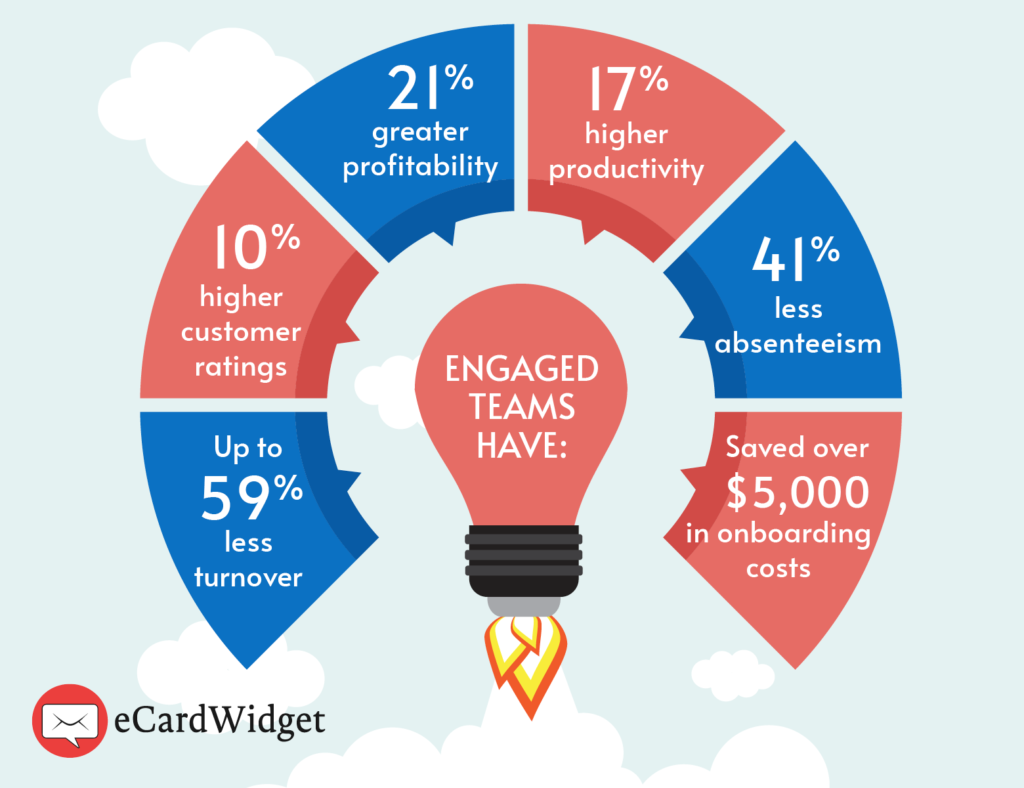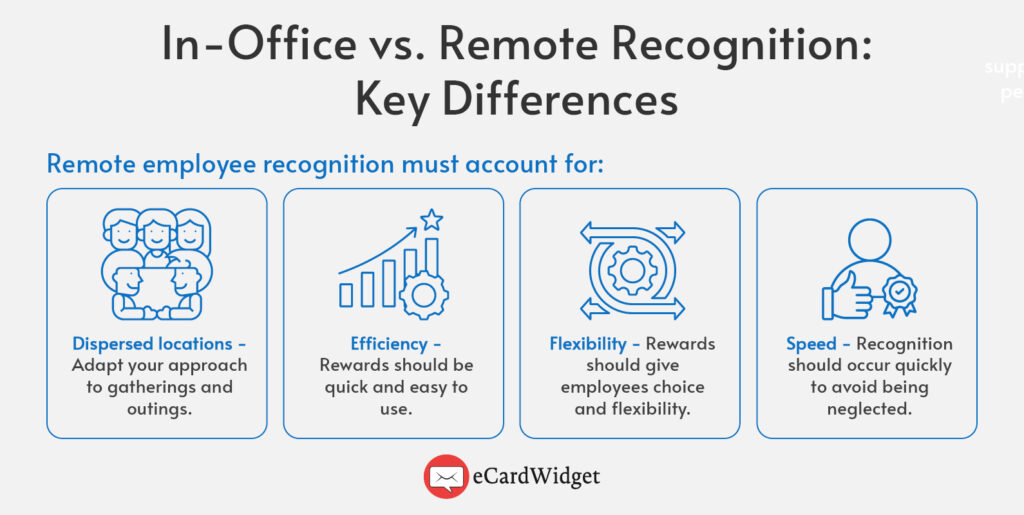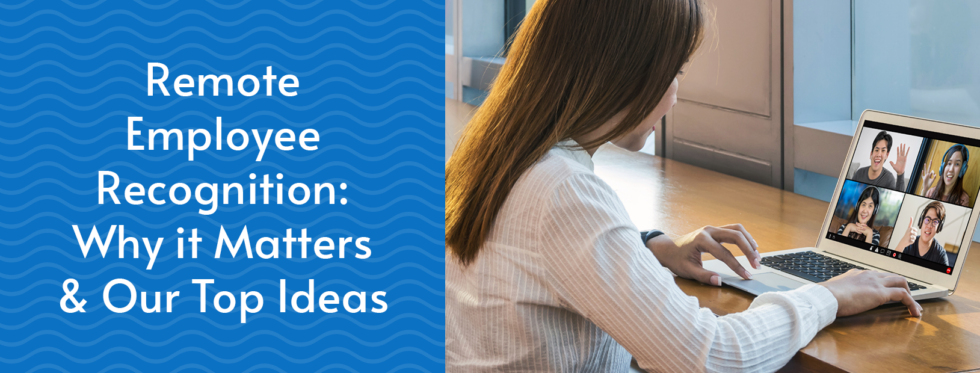Remote work is here to stay for many industries, and it brings powerful benefits.
In fact, studies have found that remote work makes employees 74% less likely to depart for new opportunities, and 80% of employees report that remote work makes them happier and more satisfied in their roles. Improved retention and increased efficiencies are big value-adds for businesses that commit to fully remote or hybrid arrangements.
But despite these benefits, there is one major downside to remote work: the lack of in-person interaction makes building relationships a challenge.
Organizations have found various creative solutions in the past few years, including a heightened effort to recognize employees working from home. But why does remote employee recognition matter? How do its best practices differ from those for traditional, in-person recognition? This guide will cover the following key topics:
| Why does remote employee recognition matter? | Our top 13 ideas for virtual employee recognition |
| How should it differ from in-office recognition? | Engagement and recognition resource library |
What’s the best recognition idea?
Want to jump right into exploring our favorite employee recognition idea for remote teams?
Why Does Remote Employee Recognition Matter?
Employee recognition is an integral part of running a sustainable business because it increases employee engagement and investment in the organization’s overall success. It’s especially important for remote teams since relationships among employees and managers cannot be built in the same day-to-day ways that they would be in a traditional, in-office environment.
Benefits of Remote Employee Recognition Programs
The biggest underlying benefit of effective recognition is that it increases overall employee engagement, which can drive some significant positive outcomes for your organization:

Gallup found that highly engaged teams experience significantly reduced turnover (-59%), absenteeism (-41%), and onboarding costs (-$5,000), plus increased customer satisfaction ratings (+10%), profitability (+21%), and productivity (+17%).
In addition, centering recognition in your employee engagement strategies can help you achieve:
- Increased employee motivation: Knowing that peer recognition, structured rewards programs, and corporate gifts are on the table helps employees feel more excited about driving business goals forward.
- A positive workplace culture: Managers and team members shouting out one another’s accomplishments fosters a supportive culture that brings teams closer together despite distance.
- Overall reduced costs: All of the benefits of employee engagement and recognition (especially reduced turnover) can significantly reduce overhead costs over time as employees strive to drive results and grow in their roles.
For organizations that can strike the right balance of remote efficiency and team engagement through consistent recognition, the sky’s the limit—but it all hinges on ensuring that remote employees feel truly valued for their contributions.

How Should Remote Employee Recognition Differ from In-Office Recognition?
Many businesses already understand the essentials of running a traditional, in-office recognition program. The challenge many now face is learning how to adapt those tactics to a remote environment.
As you adapt your recognition strategies for remote teams, it’s important to understand the fundamental differences that should inform your approach:

- Dispersed locations: Celebratory gatherings and outings won’t work well for many remote teams, but there are creative ways to work around this limitation.
- Efficiency: Heightened efficiency is a big plus of remote work since employees can focus solely on their jobs and less on in-office logistics. Recognition should be meaningful but also quick and/or not require additional time from the employee in order to enjoy or redeem.
- Flexibility: Many businesses lean into the flexibility of remote work to satisfy employees by making it easy for them to adjust their working hours or reallocate time throughout the week to handle personal errands. Rewards-based recognition should also be flexible, ideally allowing employees to choose the rewards that fit best with their preferences, goals, and schedules.
- Speed: While daily contact in an office environment makes it easy to follow up on accomplishments, the speed of work in remote settings and the added complexities of communication mean that recognition should happen fast so it isn’t lost in the shuffle.
While your organization’s culture and goals are unique and should be taken into consideration, covering these fundamental elements will help ensure that your recognition strategies will mesh well with employee preferences and needs in remote workplaces.
13 Virtual Recognition Ideas to Engage Remote Workers
Let’s dive into our favorite virtual employee recognition ideas. Each of these ideas aligns with one or more of the essential elements of remote recognition listed above, and they can be adapted to suit your needs. Mix and match them to come up with the perfect combination for your business!
1. Empower peer-to-peer recognition with eCards.
Being recognized by a supervisor is nice, but being recognized by a peer can be even more meaningful. Plus, it creates a more encouraging and engaging work environment.
Lean into this strategy by designing a collection of digital greeting cards for different occasions and making them available for any employee to send to another. Using intuitive tools like eCardWidget, any employee can choose a card, write a personal message, and send off their appreciation!
Watch this video to learn more about the positive impacts that simple recognition tactics like eCards can bring to your workplace:
We’ve seen companies and their employees use their eCards to:
- Recognize team members’ accomplishments and contributions
- Show appreciation to one another for help on a project
- Celebrate birthdays and work anniversaries
- Thank employees for participating in corporate giving or volunteering programs
- Reinforce company values by connecting them to recognized actions
This strategy is highly flexible and decentralized, meaning it won’t require significant amounts of time from managers and leadership. You’ll just have to 1) set up the new eCard process and 2) encourage employees to participate.
And since it’s a fully online process, your company gets direct insight into its effectiveness through data—quickly see how many eCards have been sent, which company values are the most represented, and more. The sky’s the limit with how you might configure your eCard approach to support your recognition and engagement goals. It’s the easiest and most flexible kind of employee recognition software to begin using.
We’ve already helped more than 3,500 organizations create flexible, easily-administered recognition strategies with eCards, and we’re just getting started! Check out these examples and learn more about our features:


2. Create a virtual leaderboard or hall of fame.
A visual representation of your recognition efforts can be an effective way to keep them top of mind for everyone.
Create a virtual leaderboard or hall of fame portion of your online employee portal (or even just a private spreadsheet or slidedeck shared among the company). Make sure it’s internally publicized and easily accessible to your team. Determine who will be in charge of keeping it updated and what criteria will be used to make changes.
This strategy is helpful because it can tie together a number of other recognition tactics and keep them visible for your whole team.
For example, use your leaderboard to keep track of how many recognition eCards have been sent across your organization, or create time-bound challenges and provide prizes or awards to the winners.
3. Offer learning and development opportunities.
One of the most meaningful ways to show employee appreciation is to invest in their skills and futures with learning and development (L&D). Consider these statistics:
- 74% of employees feel they aren’t reaching their full potential in their jobs because of a lack of development opportunities.
- 76% of employees find companies more appealing if they offer additional training to staff.
- 34% of employees who departed roles did so to secure more development opportunities, and 70% of employees report being somewhat likely to leave a role to do the same.
Here’s another important finding to note—59% of employees report investing in their own upskilling and development. There’s a proven interest, and the impact of L&D on retention (and your bottom line) can be significant, so meet your employees‘ needs!
By providing opportunities and resources for general professional development, you’ll send a message that you want to help employees grow and succeed in their careers.
Offer special L&D budgets or bonuses to recognize your high performers. Or consider giving all employees a stipend that they can use to take online certification classes, attend conferences of their choice, or subscribe to research publications in their field. Recognize engagement with these programs with leaderboards, spot prizes, and more.
4. Start an employee rewards program.
Many organizations take a structured approach to their recognition programs by creating rewards programs. These provide a concrete framework for awarding prizes and can greatly simplify the task of administering your recognition strategy.
The best part about establishing a rewards program is that you can make it entirely your own. Get flexible and creative to determine program specifics like:
- The point or credit system that the program will use
- How employees will earn points, and who will award them
- What points can be redeemed for and when (like physical prizes, extra PTO, meal delivery, etc.)
- How the program will be run (like on your website, a spreadsheet, a third-party tool, etc.)
Rewards programs work particularly well for larger organizations that have dedicated HR teams to help administer them. They can be a bit more complicated to run fairly and consistently than simpler spot bonuses and peer-to-peer shoutouts, but that shouldn’t stop you if you think a structured process of awarding redeemable points would benefit your business—just plan ahead and assign clear ownership over the program.
5. Send occasional gifts and care packages.
Even beyond a structured rewards program, recognizing employees with tangible thank-you gifts for all their hard work can go a long way to improve their experiences and deepen their ties to your business.
This strategy works because not only does it help your employees feel seen and valued, but it can also give them a visible reminder of your company, which is important in remote environments. Think about your employees’ interests and needs, then brainstorm a handful of flexible ideas that will appeal to them, like gift cards, at-home care packages, and more.
Remember that rewards for remote employees need to be flexible and easy to use and should ideally be deliverable, not needing to be picked up at specific locations.
Check out our longer guide on employee gift ideas to learn more about this strategy!
6. Make public shout-outs.
When developing your company’s overall remote employee recognition strategy, include opportunities for both private and public recognition.
Certain employees may have a strong preference for one or the other, so ask managers to take note of which individuals or teams prefer which type of recognition. If team members are interested in being recognized publicly, find or create opportunities to shout out your high achievers in places such as:
- Company-wide meetings
- Employee newsletters
- Online Hall of Fame boards (like the leaderboards described above)
- Externally-facing newsletters
- LinkedIn posts from managers and leaders
Large organizations might go even further, creating employee spotlight podcasts or interview series, allowing them to use their top performers’ wins as a way to further engage other team members and encourage them to share tips and resources.
7. Host virtual events for employees.
The most important difference between recognizing in-office and remote employees is that you can’t rely on in-person gatherings and outings.
However, that doesn’t mean you can’t still gather your team to celebrate accomplishments and recognize achievements. Virtual events may not feel the same as in-person gatherings, but they can still provide a space to build community and give employees something to look forward to. Consider hosting virtual:
- Team lunches
- Group classes, such as cooking or painting classes
- Retirement parties
You can also set guidelines that enable team members to plan and schedule their own virtual events. This gives employees more flexibility and allows them to plan exactly the kind of events they want to participate in, taking out the guesswork for leadership.
8. Give out recognition awards.
Another avenue for public recognition is to give awards to top-performing employees.
Go the traditional route and award an employee of the month, or create your own awards for things like embodying company values, promoting team harmony, or growing in their role. You can also have one award that the entire team votes on, such as the best team player award.
Recognition awards don’t have to be tangible items like trophies (though they can be). Just publicly identifying someone as a high achiever and giving them a digital certificate can be sufficient to express your appreciation. Try using eCards to deliver your digital awards!

9. Celebrate employee milestones.
In-office casual conversations help us learn more about what’s happening in employees’ lives. Working remotely means companies need to be more intentional about checking in with employees and celebrating their milestones, both personal and professional. One way to facilitate those casual conversations and recognize employees as people rather than just workers is to celebrate major events in their personal lives.
Use your company eCards to recognize when employees get promoted, reach a significant work anniversary, get married, have a baby, graduate, or move to a new place. You might also send a small gift like a box of chocolates to show your support.
10. Write LinkedIn recommendations for employees.
LinkedIn is an important professional tool in many industries today. One very easy way for managers to recognize their highest-achieving remote employees is to publicly endorse the skills that they bring to the table by writing LinkedIn recommendations.
This feature allows users to write short endorsements of others’ specific professional and technical skills. It’s a public stamp of approval that can significantly strengthen a user’s profile.
Although some employers might feel that this strategy will inadvertently encourage turnover, it should instead be thought of as an expression of appreciation and gratitude. The public, externally-facing nature of recommendations means that they’ll be especially meaningful to employees.
11. Provide spot bonuses and extra PTO.
For standout contributions, spot bonuses, gift cards, and extra paid time off can be incredibly effective ways to recognize remote employees.
These small bonuses allow you to put your money where your mouth is, so to speak, and show employees that you don’t just appreciate their achievements but recognize them as truly valuable for the business. This strategy can take a number of forms, like small $20 gift cards or larger bonuses added to paychecks.
It’s recommended to determine the criteria and process for awarding these bonuses beforehand and to establish a quarterly or annual budget for them. You’ll also need to make sure to clearly articulate why employees receive spot bonuses and the impact their hard work has had. Try using eCards about company values to deliver the announcements and reinforce their connection to your organization’s priorities.
12. Upgrade their work-from-home setups.
Since everyone works from their homes, remote employees’ work environments can vary drastically. Recognize remote employees’ needs, improve their environments, and increase productivity by upgrading their work-from-home (WFH) stations.
Do this by either providing a regular equipment stipend or by periodically sending gifts like:
- Desk organizers
- Charging stations
- Noise-cancelling headphones
- Standing desks
- Laptop stands
To get a sense of what items would be the most useful, send out a survey. Ask employees what items they currently use, what they’d like to have, and what items they think are overrated. Fold this strategy into others you might adopt, like allowing employees to use earned points in your rewards program for tech and office upgrades.
13. Regularly collect feedback on your remote recognition program.
This last strategy is especially important. For your remote employee recognition efforts to make a difference to team members, they have to be relevant and well-informed.
If you keep sending Amazon gift cards that employees don’t use or scheduling team happy hours that only a few employees enjoy, you won’t improve relationships or motivation. Instead, send out regular requests for feedback on your recognition programs—and on other aspects of the business. Ask for remote employees’ input on day-to-day operations, project management, and more to gauge their satisfaction and make improvements.
Genuine recognition includes valuing and acting on team members’ ideas, opinions, and preferences. Your remote employees want their voices to be heard, so give them plenty of opportunities to do so.

Engagement and Recognition Resource Library
The bottom line: A thoughtful, robust remote employee recognition program can improve the lives of your team members and the health of your business.
Choose the strategies that work for your company, and focus on making every act of recognition genuine, specific, and personal. Mix and match your recognition ideas, seek employee input, and track the impact—over time you’ll develop a unique recognition program that positions your company for long-term remote success.
To learn more about all the ways you can and should engage your remote workers, check out these additional resources:
- 10 Ways to Conquer Employee Recognition and Why It Matters
- Peer-to-Peer Recognition: Fostering a Strong Work Culture
- Employee Engagement Software: Crash Course & 10+ Top Options
- 170+ Corporate Gift Ideas to Impress Constituents
- How to Motivate Employees: 12 Easy Ways to Uplift Workers
- The Ultimate Guide to Succeeding in a Hybrid Work Culture



